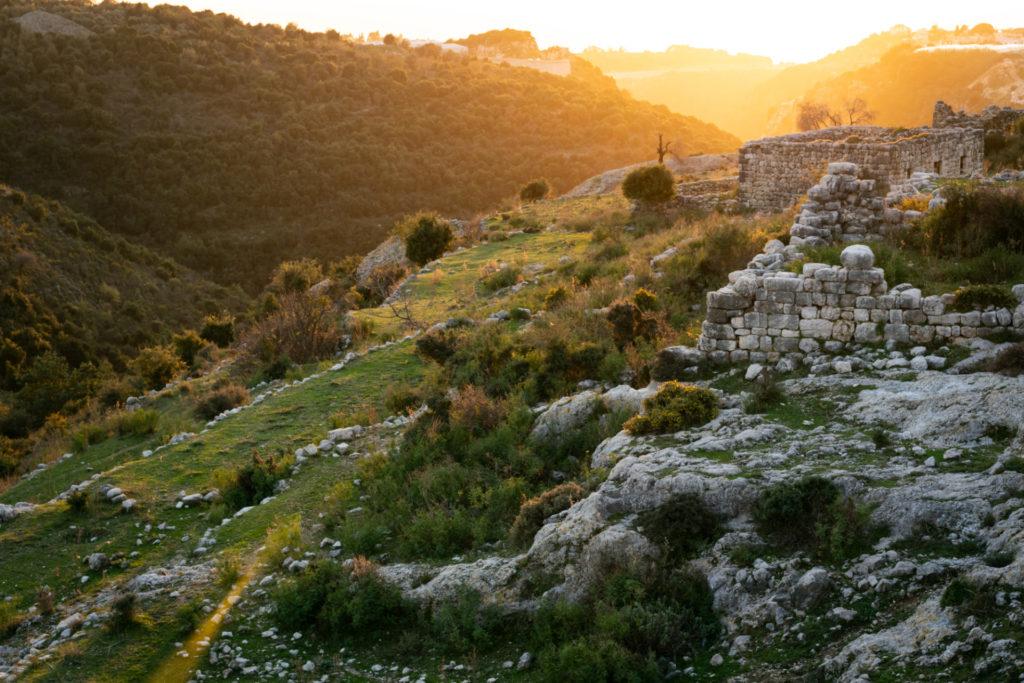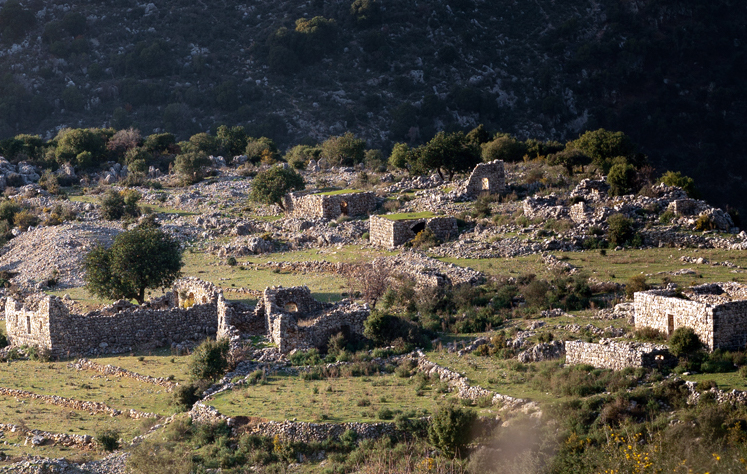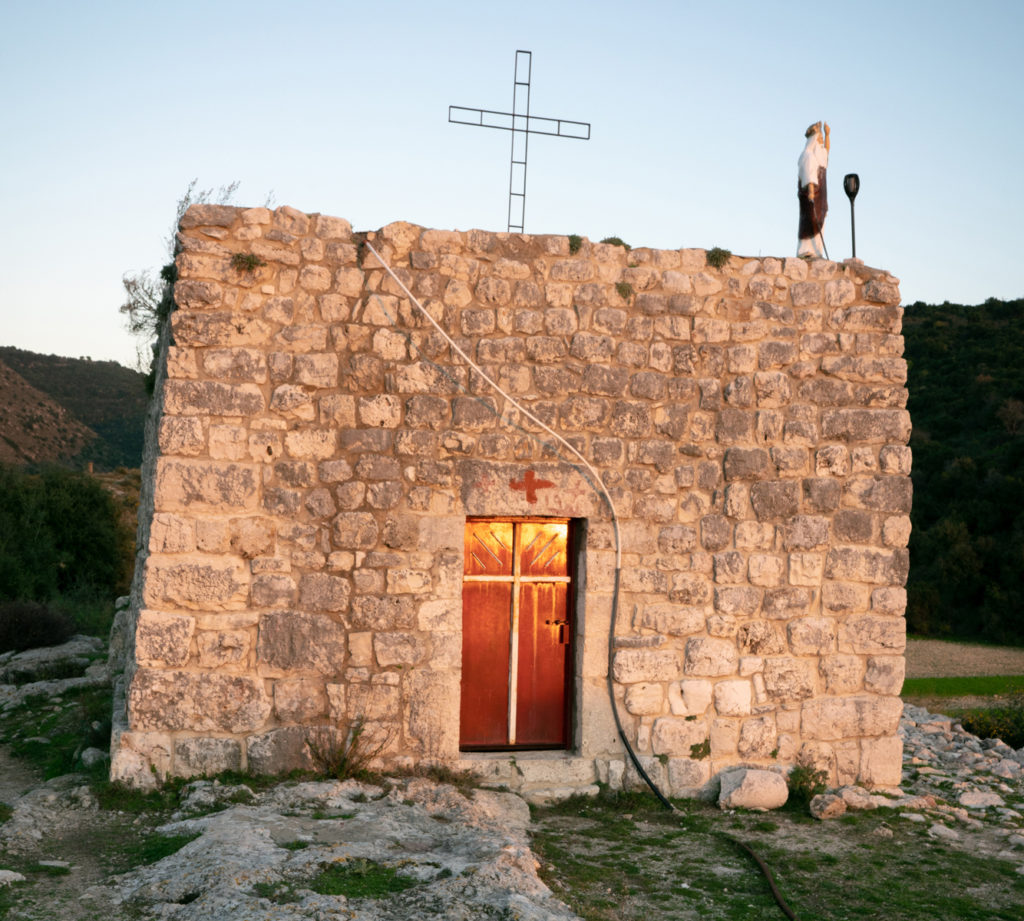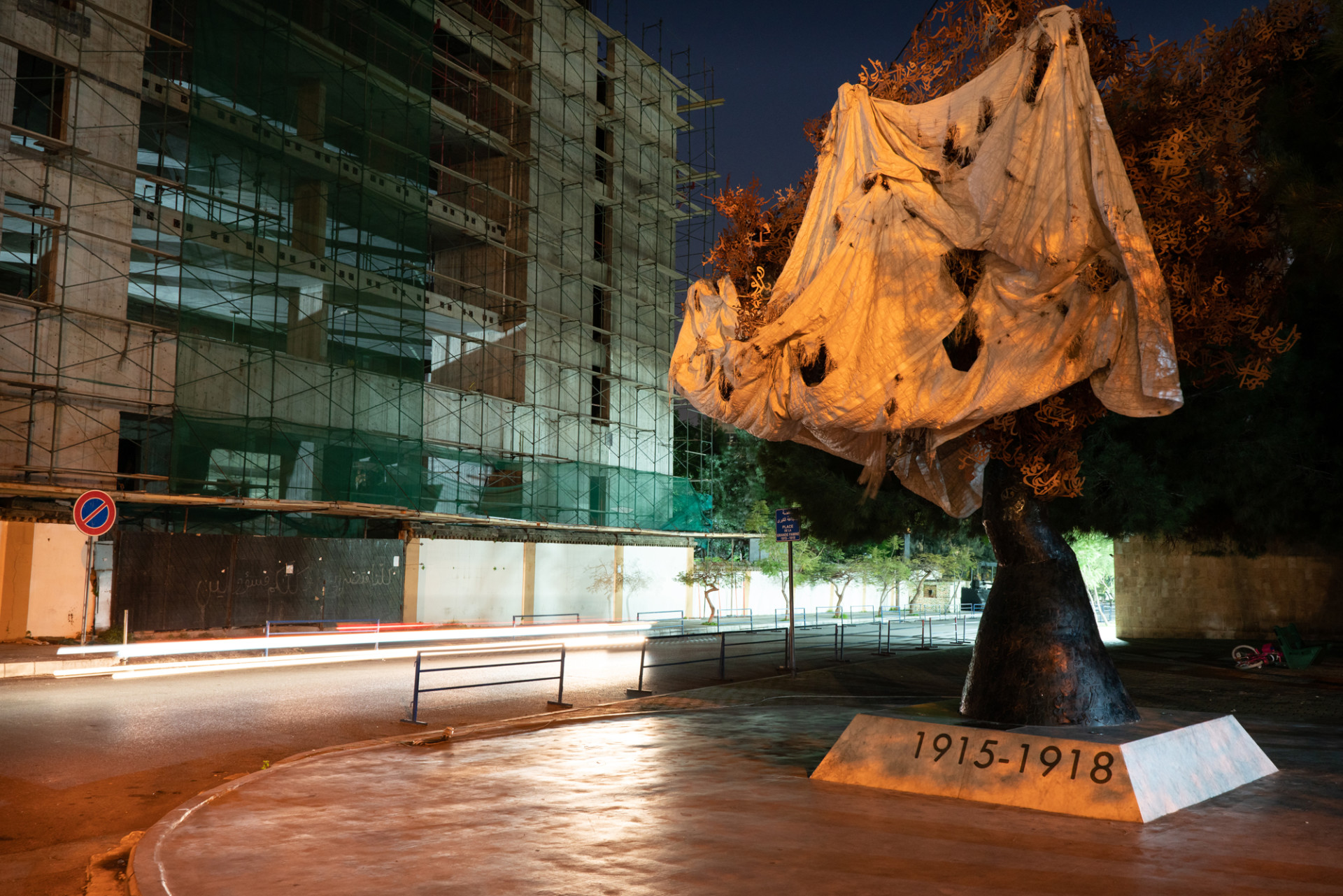When Christian Taoutel got the approval to build the first memorial to Lebanon’s worst-ever tragedy, he decided he would use it to tell the story of a nation being born.
It was around 2014, and it had been nearly 100 years since a third of Lebanon’s population, an estimated 150,000 to 300,000 out of a population of between 415,000 and 600,000, was killed by starvation and disease and another third pushed to emigrate in what has since become known as the Great Famine.
Despite the almost unfathomable scale of the disaster, with one of the highest per capita death tolls in the First World War in Beirut and Mount Lebanon (the precursors to modern-day Lebanon), officials had never created a monument to the victims.
In the time since, the country has been through a 15-year civil war that pitted Muslims and Christians against their coreligionists and against each other. There was no public memorial to that calamity either, given that warring parties entered government at the end of the conflict and carved out their own statelets and narratives, supported with their own icons and occasions.
Taoutel, the head of the history department at Saint Joseph University of Beirut, wanted something that would for once tell a story of reconciliation. He held a competition to determine the memorial’s design, and local artist Yazan Halwani won with a towering steel olive tree that, Taoutel notes, “grows in Muslim and Christian areas.”
The Memory Tree, as the monument is known, was placed on the former front line between civil war-era Muslim west and Christian east Beirut – “a point of war but also connection,” he said. Its copper leaves are ornamental Arabic calligraphy pulled from poems by revered famine-era writers and poets such as Tawfiq Yusuf Awwad and Gibran Khalil Gibran – cultural giants respected by all segments of Lebanese society.
With all this symbolism, the memory tree was supposed to forge a narrative of disparate groups sacrificing their lives so that a nation might be born. Instead, it has come to tell the story of a country in tatters. Three years after it was put up in a small square beside pine trees, the memorial is covered with a dirty white tarp that, over time, has been torn apart by the tree’s copper leaves. It was never inaugurated by the country’s sectarian leaders because of perennial political deadlock and disagreements on the minutiae of when, how, and with whom it would be made official.
“I had to get the agreement from everyone – the mayor, the governor, the president, the prime minister – and there were sensitivities about whether anyone was left out or being targeted,” Taoutel said. “I got calls saying, ‘Invite these people, don’t invite these people.’ They were trying to score political points.”
That same fickle, self-serving politics by Lebanon’s rulers has now plunged the country into a spiraling socioeconomic crisis, which is pushing people into hunger once again.
Taoutel says he prefers the monument remain in the shadows for now.
“Imagine the president inaugurating a famine memorial square when people are going hungry,” he says. “It will be destroyed by protesters the next day. The victims have been forgotten for more than 100 years, let them rest a few years more until the situation calms down.”
In Lebanon’s textbooks, both the famine and the suffering of the civil war are glossed over. Official narratives have portrayed these events either as tragedies or the result of “wars of others.” Those who died are glorified as martyrs for God or country, instead of being mourned as victims of injustice.
This is also true today: Top officials roundly declared the Lebanese victims of the Beirut port explosion martyrs and even afforded them military honors reserved for those who die in battle – never mind that it was years of criminal negligence that led to their deaths.
A different reading of these periodic calamities would find them to be large-scale, top-down injustices for which no one is ever held accountable. And there are striking parallels between Lebanon’s deliberate demise today and its famine of more than a century ago. Mismanagement, corruption, and greed by well-connected businessmen and politicians cost many lives back then and continue to do so today.
While there is no official memorial that offers a critical telling of the country’s tragic history, there is an unofficial one where it can be keenly felt. It lies outside of Beirut, in an old village ravaged by the passage of time but untainted by the revisionist hand of man.

The village of Bjerrine sits on the green shoulder of an exposed mountain overlooking the Mediterranean, in the district of Jbeil some 25 miles north of Beirut. About a dozen stone structures in varying states of disrepair blend in with limestone rock, cracked and jagged like the fossilized spine of the earth itself. Valleys fall from both sides of the town and rise northward to a bare mountain topped by faceless white buildings – the town of Hsarat – and south to the roadside town of Gherfine. Up west, on a hillside carved with wide green terraces, is the old village of Hbaline.
In the center of Bjerrine, the leaves of a large tree sway in the space where a building’s roof would once have been. Sturdy stone doorways and windows still stand, some without the walls that gave them purpose. Yellow-orange lichen grows on ashen rock.
Bjerrine was never connected to any of its neighbors by a proper road. This remains the case today, perhaps explaining why it’s the only known famine-era village in Lebanon that remains free of any modern construction. Despite the significance of this, there have been no official efforts to conserve the village – and its story has never been told.
On a recent day there, a small group of hikers said they had heard its inhabitants escaped the famine by boat in the night but died when it sank. Others believe they made it to the United States or Brazil and never returned.
A Maronite Church document from a 1932 census of the area is more brutal in its assessment: “Its inhabitants died during the war. And there is nothing in it of note.”
Neither documents nor stories have so far revealed exactly what happened in Bjerrine’s last moments. But records obtained from the church, dating back more than 150 years, allow us to construct the story of its rise and fall and place it within the wider context of the immense changes that were sweeping the land that is now Lebanon.
Bjerrine is identified as farmland belonging to the Naameh family from Gherfine. A document from an 1864 Maronite Church census says the family was originally from Beit Mery, a mountain town some 30 miles south of Bjerrine. A later census indicates they were from Lehfed, 9 miles up the mountains to the west of Bjerinne.
A wealthy family, the Naamehs employed people from neighboring villages of Hbaline, Hosrayel, and Hsarat to work their land in Bjerrine, which had a population of 45 in 1884, according to another church survey. The Maronite Church undertook these surveys to assess the state of the churches and the inhabitants of the areas where it had a footprint. The church envoy who visited Bjerrine in 1884 found that just 21 of its inhabitants – less than half – had performed their religious duties of confession, while nine people paid tithes and eight were married.
The envoy was not satisfied with the religiosity of the town’s inhabitants; many did not celebrate Easter, he wrote, and did not undertake confession or go to mass – “some not at all.” Furthermore, the town’s dead were buried in a cemetery right next to the church, “and it is not known if it has been consecrated.” Approximately 80% of the local church’s income was spent by their representative, Sarkis Tannous Dib, on restoring the old box-like chapel in the village.
Still, it remained rundown, without tiling and with only one frameless window. It was also sparsely stocked with the utensils needed for religious service, with just one silver cup, two copper candlesticks, and only one old priest’s robe. The envoy found that Dib had failed to keep accounts of spending. When asked about it, Dib replied that he did not know how to read, and no one in the town knew how to read or write. He kept the money in a special bag and would count it manually, he said – perhaps a clever excuse to cover up impropriety but more likely the truth in a village populated by peasants.
Bjerrine’s size was measured in terms of its agricultural output rather than actual area; it was a place for growing crops. Those would have been wheat, olives, tobacco, and mulberry trees to feed silkworms that produced silk for export, according to historian Paul Zgheib, a native of nearby Amchit who has studied the district of Jbeil in detail. A cavern-like dark room likely used to breed silkworms still stands in Bjerrine, a beam of light streaming through an opening where the ceiling has collapsed. Another cavernous building was likely used to store grain; its rough stone walls were smoothed over with plaster to keep out pests.
Bjerrine’s population lived in simple stone houses with niches carved into their walls that were used to store utensils and mattresses. There were no dedicated bedrooms; the floor had to be cleared of cushions during the day for work. When a member of the family got married, a wall was built through the middle of the home to allow for privacy.

Inhabitants ate large quantities of vegetables, olives and olive oil, bread and bulgur wheat, and the treacly molasses of the carob tree. Sugary sweets and meat were reserved for occasions like Easter or weddings. “Life was generally very hard for the vast majority of people at that time. It’s hard to speak of a golden era,” Zgheib said. “They worked to live, while wealthier people – traders, exporters, and merchants – became rich.”
Under the Ottoman Empire for 400 years, between 1516 and 1918, Mount Lebanon moved from subsistence agriculture to regional trade before being integrated into globalized capitalism. By the 1800s, the country produced a large amount of cash crops like tobacco and various fruits and legumes. Its largest trade by far was silk. Mulberry trees were grown for their leaves, the only thing silkworms would eat, and the material they produced was woven in local factories before being sent to Europe. By 1880, silk exports accounted for 50% of all revenues in Mount Lebanon, according to Melanie Tanielian in The War of Famine: Everyday Life in Wartime Beirut and Mount Lebanon. Instead of growing to eat, people increasingly grew to sell and then bought food originating from elsewhere.
Being on the periphery, Bjerrine was a small part of that international system.
When cheaper silk from China entered European markets in the mid-1800s and became favored over the Lebanese version, demand for Lebanon’s silk dropped by more than 50%. At the same time, trade and tourism were growing and could provide a means of livelihood.
People who lived in the mountains began to drift toward the cities. Others emigrated toward the Americas or Australia. By 1900, a Maronite Census shows that Bjerrine’s population had dropped from 45 to 26, of whom all but six performed their religious duties of confession. They lived in seven houses, 10 paid tithes, four were married, and there were seven children.
The names of some families living there were given for the first time: the Hanjoul family from Hosrayel and the Ibrahim Francis family from Hbaline. Bjerrine’s priest, Youssef Saadeh from Hsarat, “only rarely does mass” for his flock, the emissary wrote.
The small hamlet was in decline before the start of the First World War. When the war began, the Ottomans joined Germany. In response, England, France, and Russia declared a naval blockade of the empire and closed off the coast of territories in the eastern Mediterranean, including modern-day Beirut and Mount Lebanon.
Lebanon’s export-focused economy collapsed. Meanwhile, remittances from tens of thousands of Lebanese – a primary source of income even back then – could not get in. The Ottomans shut down foreign banks, barring many people from access to their money. Whatever they could retrieve lost much of its value on exchange markets as the currency depreciated.
The Ottomans then began to requisition grain and farm animals for the war effort and instituted mandatory conscription into the army that fell mostly onto peasants in the countryside, as wealthier people could pay their way out. The result was that farmland was left unsown and crops unharvested.
The price of a single loaf of bread soon became equal to, and then outpaced, the daily wage of an unskilled worker. People began to starve.
Heat waves and a particularly dry winter slashed the harvest of 1915, and successive swarms of locusts, so thick that eyewitnesses wrote that they blocked out the sun, devoured what remained. The price of a single loaf of bread soon became equal to, and then outpaced, the daily wage of an unskilled worker. People began to starve.
Scholars who have studied this period have since discovered an uncomfortable truth: There was likely more than enough grain in the region to feed everyone – it just didn’t get where it needed to go.
Jamal Pasha, the commander of the Ottoman Fourth Army Corps in Greater Syria, had a laissez-faire attitude and failed to resolve the famine at its outset in 1914 and 1915. He then handed out wheat concessions to local notables, traders, and merchants and tasked them with supplying grain to the population. They were told to sell at an official rate. Many instead hoarded goods so they could later sell at higher prices. Smaller distributors would cut wheat with dirt, sawdust, and sand to increase its weight. Some bakeries further cut it, so that some bread was of such poor quality that it was reported to turn black within two days.
The black market for everything from wheat to sugar and medicines flourished. Corruption proliferated around access to basic goods. Many in Beirut starved, not because there was no food but because they couldn’t afford to buy it; they died of disease, not because it was incurable but because they had no access to the medicine they needed. With their bodies weakened, outbreaks of digestive diseases like typhus and cholera, as well as malaria and yellow fever, began. The moans of the deprived filled the soundscape, falling silent on roads littered with emaciated corpses.
In the end, Beirut’s prewar population of around 150,000 was roughly halved.
The situation was much worse in Mount Lebanon. Little grain made its way to the villages, the result of hoarding in the capital and Byzantine Ottoman regulations that prevented the movement of goods. In Mount Lebanon, even the bourgeoisie suffered.
Zgheib, the historian from Amchit, which is just a couple of miles from Bjerrine, spoke to people who said they or their relatives had sold vast lands, jewelry, and boats for a few precious bags of flour. Priests fled their parishes. Starving people drifted down the mountain from village to village and into cities, carrying and spreading disease. Most villages lost an average of a third to two-thirds of their inhabitants. Entire towns were emptied out.
Bjerrine was a bad place to be at the time. Suffering from crop failure, its inhabitants also had to contend with disease that would have easily proliferated in a series of rainwater wells that were their only source of drinking water.
While it remains difficult to say how the village became empty, the sea, tantalizing in front of Bjerrine, would have been no escape during the war due to the total naval blockade.
Instead, inhabitants of this region generally traveled to large cities, many only emigrating after the war was over. The coastal city of Jounieh, almost 20 miles south, would have been the closest option for Bjerrine’s inhabitants – but those who went there would have had to compete with thousands of hungry refugees who had also escaped the mountain. If they took the longer and more perilous route north toward Tripoli, they would have faced better odds, for Tripoli was part of a different Ottoman district at the time from Beirut and Mount Lebanon, and was relatively insulated from the famine.
“The war effectively turned the family from a locus of safety and security to a place of competition over food, as brothers denied bread to brothers and fathers and mothers were forced to abandon their children,” Tanielian wrote, adding that there was “no doubt as to how the deprivations severed the tendons of power and trust once joining family members and, by extension, communities.”
The war ended in 1918. When a church emissary arrived in Bjerrine in 1932, he found the village abandoned. “Its inhabitants died during the war. And there is nothing in it of note,” he wrote.

Hunger is back on people’s tongues in Lebanon today. People talk about deprivation openly on the airwaves, be they protesters blocking roads or experts who warn that large parts of the population could face food shortages.
“Don’t let a bastard who is full tell you to be patient about your hunger,” read graffiti spray-painted on a Beirut wall during recent protests.
While some headlines traffic in alarmism, there are striking similarities between Lebanon’s situation today and the Great Famine.
The country’s economy, overly dependent on importing everything from food to fuel, has been crushed as the currency has lost most of its value. The agricultural sector is ill-prepared to meet rising demand, while traders who enjoy near-monopolies in sectors from food to medicine are hoarding goods and making shortages worse. Sporadic efforts by officials to combat the greed of traders have had little effect. The black market for basic necessities is flourishing, and people are making pleas to Lebanese abroad for help.
But there is ultimately one important difference between now and 1914-1918. What could then be attributed to occupiers and war, to nature and the wrath of God, is now being brought upon the Lebanese entirely by their own rulers.
Lebanon is victim to a predatory political system that has made a tiny group of leaders and their clients very rich and continues to preserve their interests at the expense of the population.
There is no blockade, naval or otherwise. Though the threat of war is ever present, there is no rash requisitioning of food, property, or people. Instead, Lebanon is victim to a predatory political system that has made a tiny group of leaders and their clients very rich and continues to preserve their interests at the expense of the population.
For all their ills, the Ottomans did make efforts – however failed – to resolve the famine they had caused. Today, Lebanon’s rulers make no such efforts to stop the spiraling crisis, instead choosing to practice a deliberate policy of doing nothing.
This makes Bjerrine more than a reminder to contemplate Lebanon’s troubled past. Like all memorials, it is a warning about the uncertain future.
And it reminds us that those who died in the famine did not fall for Lebanon, nor even for church or religion – which, as we have seen, many of them did not even practice.
They died of hunger. They lived difficult lives and died inglorious, undignified deaths. They fled Lebanon if they could, and, much like today, most remained only if they had to – at their peril.
Gibran Khalil Gibran had said as much in his poem “Dead Are My People,” written during the famine and dedicated to its victims. Excerpts from it were woven into the Memory Tree.
“But my people did not die as rebels;
They were not killed in the field
Of battle; nor did the earthquake
Shatter my country and subdue them.
Death was their only rescuer, and
Starvation their only spoils.”



